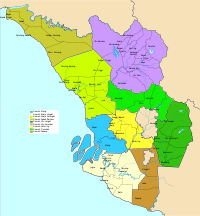Kuala Lumpur International Airport
Kuala Lumpur International Airport (KLIA) (Bahasa Malaysia: Lapangan Terbang Antarabangsa Kuala Lumpur), (IATA: KUL, ICAO: WMKK) is Malaysia's main international airport and one of the biggest airports in Southeast Asia and worldwide. It is located in Sepang District of Selangor, approximately 45 kilometres (28 mi) south of Kuala Lumpur city centre and serves the Greater Klang Valley conurbation.
Kuala Lumpur International Airport | |||||||||||||||||||
|---|---|---|---|---|---|---|---|---|---|---|---|---|---|---|---|---|---|---|---|
 | |||||||||||||||||||
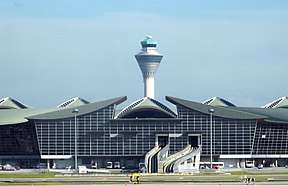 | |||||||||||||||||||
| Summary | |||||||||||||||||||
| Airport type | Public | ||||||||||||||||||
| Owner | Khazanah Nasional | ||||||||||||||||||
| Operator | Malaysia Airports | ||||||||||||||||||
| Serves | Greater Kuala Lumpur, Negeri Sembilan, Malacca | ||||||||||||||||||
| Location | Sepang, Selangor, Malaysia | ||||||||||||||||||
| Hub for | |||||||||||||||||||
| Time zone | MST (UTC+08:00) | ||||||||||||||||||
| Elevation AMSL | 70 ft / 21 m | ||||||||||||||||||
| Coordinates | 02°44′36″N 101°41′53″E | ||||||||||||||||||
| Website | www | ||||||||||||||||||
| Maps | |||||||||||||||||||
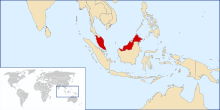 Selangor state in Malaysia | |||||||||||||||||||
 KUL /WMKK  KUL /WMKK KUL /WMKK (Peninsular Malaysia)  KUL /WMKK KUL /WMKK (Malaysia) 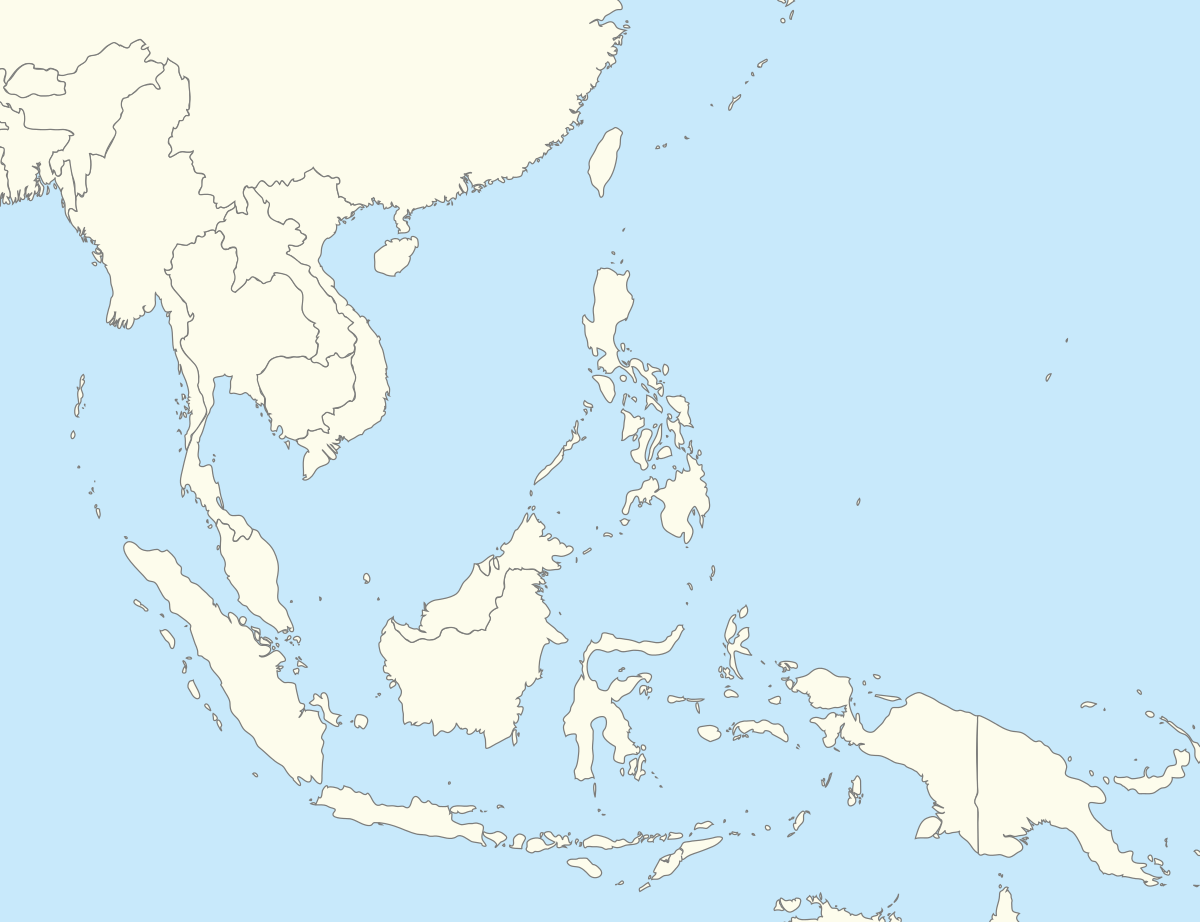 KUL /WMKK KUL /WMKK (Southeast Asia) 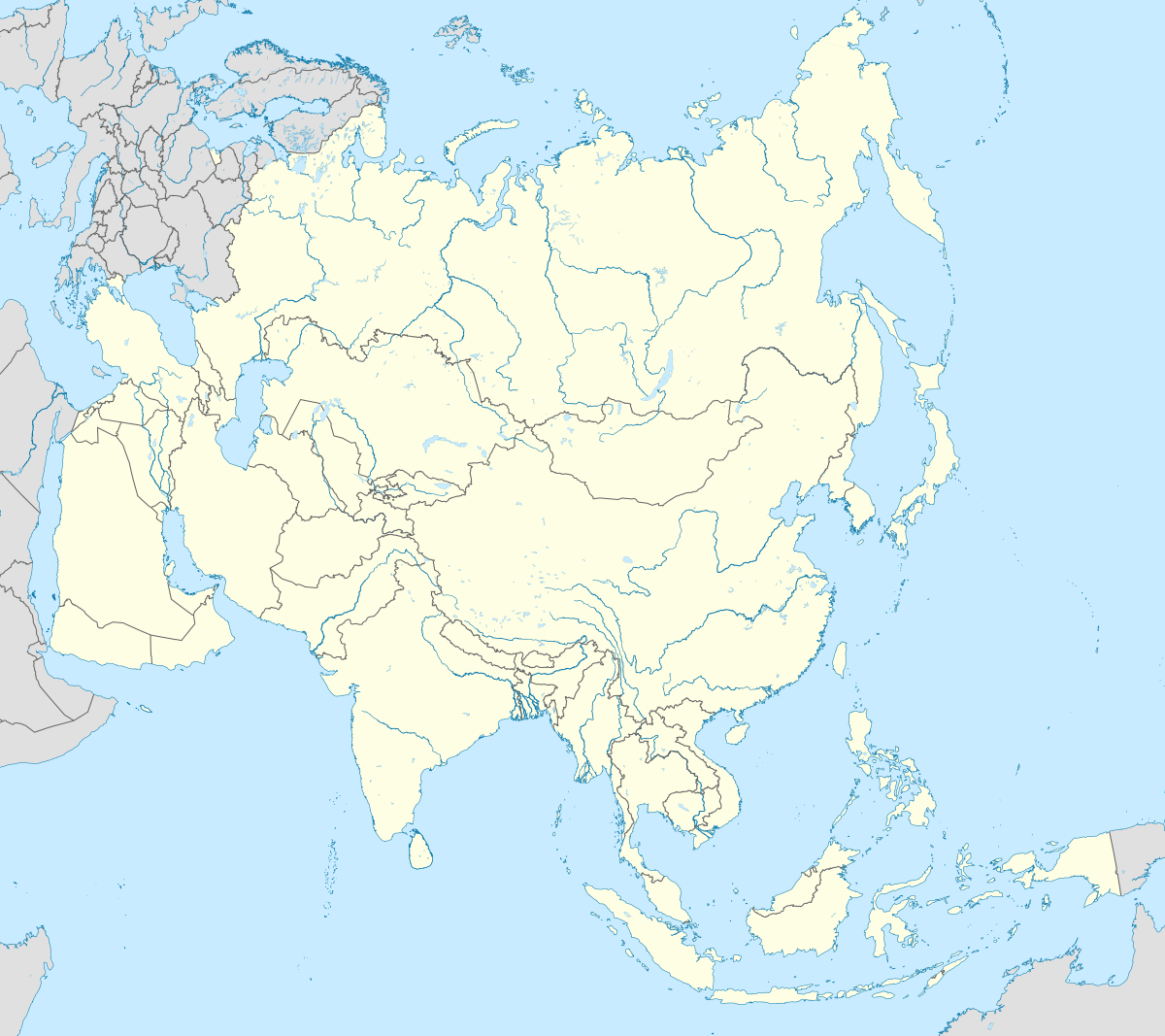 KUL /WMKK KUL /WMKK (Asia) | |||||||||||||||||||
| Runways | |||||||||||||||||||
| |||||||||||||||||||
| Statistics (2018) | |||||||||||||||||||
| |||||||||||||||||||
KLIA is the largest and busiest airport in Malaysia. In 2018, it handled 59,988,409 passengers, 714,669 tonnes of cargo and 399,827 aircraft movements. It is the world's 23rd-busiest airport by total passenger traffic.
The airport is operated by Malaysia Airports (MAHB) Sepang Sdn Bhd and is the major hub of Malaysia Airlines, MASkargo, AirAsia, AirAsia X, Malindo Air, flyGlobal, UPS Airlines and AsiaCargo Express.
History
Background
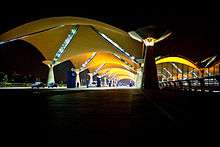
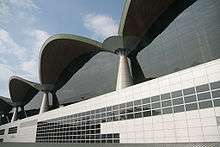
The ground breaking ceremony for Kuala Lumpur International Airport (KLIA) took place on 1 June 1993 [3] when the government under Mahathir Mohamad decided that the existing Kuala Lumpur airport, then known as Subang International Airport (now Sultan Abdul Aziz Shah Airport) could not handle future demand. The construction of the airport was done mainly by a few state owned construction companies as well as Ekovest Berhad – helmed by Tan Sri Datuk Lim Kang Hoo. It was created as part of the Multimedia Super Corridor, a grand development plan for Malaysia. The chief architect who designed the new airport terminal was the Japanese architect Kisho Kurokawa.[4]
Upon KLIA's completion, Subang Airport's Terminal 1 building was demolished. Malaysia Airports agreed to redevelop the remaining Terminal 3 to create a specialist airport for turboprop and charter planes surrounded by a residential area and a business park. The IATA airport code KUL was transferred from Subang Airport, which currently handles only turboprop aircraft, general aviation and military aircraft. Subang Airport's IATA code has since been changed to SZB.
Current site
The airport's site spans 100 square kilometres (39 sq mi) 2,[5] of former agricultural land and is one of the world's largest airport sites. An ambitious three-phase development plan anticipates KLIA to have three runways and two terminals each with two satellite terminals.[6] Phase One involved the construction of the main terminal and one satellite terminal, giving a capacity of 25 million passengers, and two full service runways. The Phase One airport had sixty contact piers, twenty remote parking bays with eighty aircraft parking positions, four maintenance hangars and fire stations. Phase Two, designed to increase capacity to 35 million passengers per year is largely complete. Phase Three is anticipated to increase capacity to 100 million passengers per year.[6]
Grand opening
Kuala Lumpur International Airport was officially inaugurated by the 10th Yang di-Pertuan Agong, Tuanku Ja'afar of Negeri Sembilan, on 27 June 1998 at 20:30 MST, a week ahead of Hong Kong International Airport and in time for the 1998 Commonwealth Games. The first domestic arrival was Malaysia Airlines flight MH1263 from Kuantan at 07:10 MST. The first international arrival was Malaysia Airlines flight MH188 from Malé at 07:30 MST. The first domestic departure was Malaysia Airlines flight MH1432 to Langkawi at 07:20 MST; the first international departure was Malaysia Airlines flight MH84 to Beijing at 09:00 MST.[7]
Recent events
- On 13 February 2017, Kim Jong-nam, the half-brother of North Korean leader Kim Jong-un, was assassinated with the nerve agent VX while walking at Kuala Lumpur International Airport2 (klia2). Two women, who were alleged to have grabbed him to deploy the nerve agent, were arrested. Kim was traveling under a pseudonym.[8]
- On the night of 21 August 2019, the airport suffered disruption due to network failure, this has caused disruption to several airport systems such as WiFi connection, Flight Information Display System, check-in-counters and the baggage handling systems.[9]
Inauguration
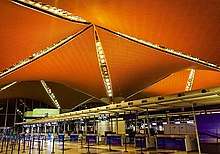

The inauguration of the airport was marked with problems. Aerobridge and bay allocation systems broke down, queues built up throughout the airport and baggage handling broke down. Bags were lost and there were waits of over five hours.[10] Most of these issues were remedied eventually, though baggage handling system was plagued with problems until it was put up for a complete replacement tender in 2007.
The airport suffered greatly reduced traffic with the general reduction in economic activity brought about by the 1997 Asian financial crisis, SARS, bird flu epidemic (Avian flu), the financial crisis of 2007–2008, and the swine flu pandemic. 1998 saw a reduction of passenger numbers as some airlines, including All Nippon Airways (resumed on 1 September 2015), British Airways (reinstated on 28 May 2015), Lufthansa (resumed between 28 March 2004[11] until 28 February 2016)[12] and Northwest Airlines, terminated their loss-making services to KLIA. KLIA's first full year of operations in 1999, in its Phase One manifestation (capacity of 25 million passengers per year), saw only 13.2 million passengers.[13] Passenger numbers eventually increased to 21.1 million in 2004 and 47 million in 2013[14] — though short of the originally estimated 25 million passengers per year by 2003.
Runways
Kuala Lumpur International Airport has three parallel runways (14L/32R, 14R/32L, 15/33[15]), a first in the region. The aircraft movements on these runways are monitored by two Air Traffic Control (ATC) Towers; Tower East, and Tower West given the span of the airport. ATC Tower West standing at 133.8m, is currently the tallest ATC tower in the world.
The current three runway system is capable of handling 78 landings per hour and is expected to increase to 108 landings per hour once upgrading of the Kuala Lumpur Flight Information Region is completed in 2019.[16] These runways operate on different departure/arrival modes according to the air traffic requirements.[17]
Operations and infrastructure
| Infrastructure | ||
|---|---|---|
| Passenger terminal buildings | ||
| Totals | Current | |
| Floor area | 737,249 m2 (7,935,680 sq ft) | |
| Handling capacity | 70 million passengers per year | |
| Parking bays | 114 (aerobridge) 48 (remote) | |
| Main Terminal Building 1 & Contact Pier | ||
| Opened | 27 June 1998 | |
| Floor area | 336,000 m2 (3,620,000 sq ft) | |
| Handling capacity | 5 million passengers per year | |
| Parking bays | 20 (aerobridge) 23 (remote) | |
| Satellite Terminal A | ||
| Opened | 27 June 1998 | |
| Floor area | 143,404 m2 (1,543,590 sq ft) | |
| Handling capacity | 20 million passengers per year | |
| Parking bays | 26 (aerobridge) 15 (remote) | |
| klia2 | ||
| Opened | 2 May 2014 | |
| Floor area | 257,845 m2 (2,775,420 sq ft) | |
| Handling capacity | 45 million passengers per year | |
| Parking bays | 68 (aerobridge) 10 (remote) | |
| Bunga Raya Complex | ||
| Opened | 27 June 1998 | |
| Floor area | ||
| Handling capacity | ||
| Parking bays | 1 | |
KLIA features a number of modern design features that assist in the efficient operation of the airport. It is one of the first Asia Pacific airports to become 100% Bar Coded Boarding Pass capable.[18] Malaysia Airlines;[19] AirAsia;[20] MASkargo, a cargo airline;[21] and Malaysia Airports, the Malaysian Airports operator and manager; are headquartered on the property of KLIA.[22] Malaysia Airlines also operates its Flight Management Building at KLIA.[23]
Terminals
The airport is part of the KLIA Aeropolis, and is made up of two main terminals; the original terminal, KLIA Main and the new terminal 2, also known as klia2. KLIA Main was designed by Japanese architect Kisho Kurokawa, with an emphasis of natural lighting within the airport complex. Spanning 38.4m along a grid pattern allowing for future expansions, the abstract symbolic architecture by the late Kisho Kurokawa encompasses the Islamic geometry and cutting edge technology with the tropical rainforest in mind.[24]
KLIA
Main Terminal Building
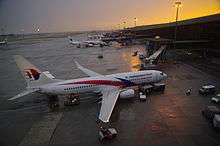
The KLIA Main Terminal Building (MTB) now also referred to as KLIA Main is located in between the two runways. The floor area of the terminal covers 390,000 m2 (4,200,000 sq ft) and the building consists of 39 square roof units, which enables future expansion of the building. There are a total of 216 check-in counters, located in 6 different islands, identified by the letters A – M (excluding I). Multi check-in services are available, designed for the use of all passengers arriving, departing or in transit. Self check in facilities are available in this airport since 2007,[25][26] and KLM was the first airline to use the Common-use self-service kiosks. The contact pier is an extension of the main terminal building with gates marked with prefix A and B for domestic departures, G and H for international flights. The gate allocation is based on operational requirements, although it has been observed that Malaysia Airlines has been operating most of its operations out from the contact pier.
Satellite terminal A
.jpg)
The 176,000 square metres (1,890,000 sq ft) satellite building accommodates international flights departing and arriving at KLIA. Passengers have to travel to the satellite building via the Aerotrain. There is a wide array of duty-free shops and prestige brand boutiques in the satellite building. This includes international brands such as Burberry, Harrods, Montblanc, Salvatore Ferragamo. Among all international labels available within the terminal, some boutiques such as Harrods are only available in the airport. A number of restaurants and international airlines' lounges are available as well as an Airside Transit Hotel.
Within the terminal, wireless internet (Wi-Fi) is provided free of charge. The terminal also has prayer rooms, showers and massage service. Various lounge areas are provided, some including children's play areas and movie lounge, broadcasting movie and sport channels.[27] The terminal also features a natural rainforest in the middle of the terminal, exhibiting the Malaysian rainforests.
Under Malaysia Airports Berhad retail optimisation plan, the retail space in satellite terminal A will be further optimised to increase its revenue derived from commercial space rental and a percentage of sale receipts to 50% by year 2010 which currently stands at 35%. Some notable improvements that will be seen after the refurbishments will be the Jungle Boardwalk[28] which will be the first of its kind in the world and larger mezzanine floor to accommodate F&B outlets and viewing galleries.[29]
The gates in Satellite Terminal A have the prefix C. The Satellite A terminal has 27 boarding gates altogether.
KL City Air Terminal
KL City Air Terminal, sometimes known as Kuala Lumpur City Air Terminal or KL CAT located at KL Sentral is a virtual extension of KL International Airport where city check-in services are provided. KL City Air Terminal is recognised by the International Air Transport Association (IATA) and carries the IATA designation XKL. Currently there are only three airlines providing city check-in services, they are Cathay Pacific, Malaysia Airlines and Malindo Air.[30]
KLIA2 (Terminal 2)


Built at approximately RM4 billion, it is the largest purpose built terminal optimised for low-cost carriers in response to the exponential growth of low-cost travel in the region. It was built to replace the previous Low Cost Carrier Terminal (LCCT). klia2 started its operations on 2 May 2014 and all flight operations at LCCT were moved to klia2 by 9 May 2014.[31][32]
As part of its development, a third runway (Runway 15/33) and a new air traffic control tower (Tower West) were built to support its operation. klia2 has an initial capacity of 45 million passengers per year. The terminal has a built-up area of 257,845 sqm with 68 departure gates, 10 remote stands, 80 aerobridges, includes a retail space of 35,000 sqm to accommodate a total of 220 retail outlets.[33] The main terminal building of klia2 is connected with its satellite piers with a skybridge, making it the first airport in Asia with such facility.[34] klia2 is certified with Leadership in Energy & Environmental Design (LEED).
Check-in counters are divided into 8 rows located in 4 islands, each row identified by the letters S – Z. Boarding gates are located in 5 piers, indicated by the letters J and K for domestic flights, and L, P and Q for international flights. Piers J, K and L are connected directly to the main terminal building, while Piers P and Q are accessible via the skybridge. Piers K and L are physically the same pier and share the same gates, but with waiting lounges on different levels (Level 1A for K and Level 2 for L). For international flights, the access door from Pier K is sealed off, while for domestic flights, the access door from Pier L is sealed off instead.
At present, inter-terminal connection is provided on the landside at Gateway@klia2 complex and there are provisions for future airside inter-terminal connection.
Gateway@klia2
Gateway@klia2 is an integrated shopping complex that is connected to the main klia2 terminal building. It has a 350,000 square feet of net lettable space spanning over four levels. The transport hub at Gateway@klia2 links klia2 to the KLIA Ekspres and KLIA Transit service, with allotted pick-up and drop-off areas for coaches, taxis, rented vehicles and private transportation.[35]
Gateway@klia2 hosts an 8-storey car park that directly adjoins klia2. There are 6,000 covered parking lots at Blocks A and B and another 5,500 lots at car park D. Shuttle buses are available to take the public from the car park D to the terminal.[36] The first capsule transit hotel in Asia named as the Capsule by Container Hotel is also located at Gateway@klia2. Gateway@klia2 is managed by WCT Holdings Berhad.[37]
Former low cost carrier terminal (LCCT)
The now defunct 36,000 square metres (390,000 sq ft) low cost carrier terminal (LCCT) was opened at Kuala Lumpur International Airport on 23 March 2006 to cater for the growing number of users of low-cost airlines, especially the passengers of Malaysia's "no-frills" airline, AirAsia. The terminal was designed and built in accordance to the low cost carrier business model, with limited terminal amenities. As requested by the low-cost airline, the terminal does not provide aerobridges, nor are there transfer facilities, rail connections, and other facilities provided in a full-fledged terminal. LCCT is located within the Air Support Zone, and has since ceased operations on 9 May 2014 and all low-cost carrier flights are now operating out of klia2.
Airlines and destinations
Passenger
Cargo
| Airlines | Destinations |
|---|---|
| AsiaCargo Express | Kota Kinabalu, Kuching, Miri |
| Cargolux | Baku, Luxembourg, Singapore, Zhengzhou[85] |
| China Airlines Cargo | Taipei–Taoyuan |
| FedEx Express | Guangzhou, Penang |
| Korean Air Cargo | Penang, Seoul–Incheon |
| MASkargo | Amsterdam,[86] Bangkok–Suvarnabhumi,[87] Bengaluru, Chennai, Chongqing,[88] Delhi,[87] Dhaka, Guangzhou,[88] Hanoi, Ho Chi Minh City, Hong Kong, Jakarta–Soekarno–Hatta, Kota Kinabalu, Kuching, Labuan,[89] Macau, Manila, Mumbai, Penang, Shanghai–Pudong, Sydney, Taipei–Taoyuan, Tokyo–Narita[90] |
| My Jet Xpress Airlines | Kota Kinabalu, Singapore |
| Silk Way Airlines | Amsterdam, Baku,[91] Frankfurt, Singapore[92] |
| Turkish Cargo | Ho Chi Minh City, Istanbul-Atatürk[93] |
| UPS Airlines | Penang,[94] Shenzhen |
Statistics
|
| ||||||||||||||||||||||||||||||||||||||||||||||||||||||||||||||||||||||||||||||||||||||||||||||||||||||||||||||||||||||||||||||||||||||||||||||||||||||||||||||||||||||||||||||||||||||||||||||||||||||||||||||||||||||||||||||||||||||||||||||||||||||||||||||||||||||||||||||||||||||||||||||||||||||||||||||||||||||||||||||||||||||||||||||||||||||||||||||||||||||||||||||||||||||||||||||||||||||||||||||||||||||||||||||||||||||||||||||||||||||||||||||||||||||||||||||||||||||||||||||||||||||||||||||||||||||||||||||||||||||||||||||||||||||||||||||||||||||||||
Ground transportation
Inter-terminal transportation
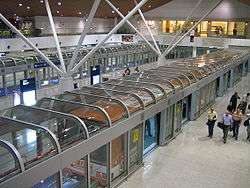
The Aerotrain is an automated people mover (APM) that connects the airside of KLIA Main Terminal Building (MTB) and the Satellite Building. Each 250-person capacity train can transport 3,000 passengers per hour in each direction at up to 56 km/h (35 mph). These three-car driverless trains run on elevated rail and under the taxiways. The journey takes under two minutes. The Aerotrain operates between three and five-minute intervals between terminal. Automatic train controls manage the operation of the entire Aerotrain system, controlling the speeds, headways, stops and door openings in stations, and integrating functions that enhance the reliability and performance of the system.[96]
External connections
Rail
Kuala Lumpur International Airport is linked to the KL Sentral transportation hub in the city centre by the 57 km (35 mi) long Express Rail Link (ERL). There are two ERL stations at the airport: KLIA station at the Main Terminal Building and klia2 station at Gateway@klia2. The airport is served by two rail services on the ERL:
- KLIA Ekspres: The dedicated airport rail link which runs non-stop between KL Sentral and KLIA. The journey takes 28 minutes to/from KLIA, and 33 minutes to/from klia2 with a two-minute stop at KLIA. The KLIA Ekspres terminal at KL Sentral is known as the KL City Air Terminal (KL CAT), which has an IATA designation XKL. KL CAT offers in-town flight check-in service up to two hours before flight departure time for passengers travelling on Cathay Pacific, Emirates, Etihad Airways, Malaysia Airlines, Malindo Air and Royal Brunei Airlines.
- KLIA Transit: A commuter rail service which stops at three additional stops (Bandar Tasik Selatan, Putrajaya/Cyberjaya and Salak Tinggi) between KL Sentral and KLIA. The journey takes 35 minutes to/from KLIA and 39 minutes to/from klia2. Check-in facilities are only through automated kiosks at KLIA Transit stations.
Taxis and limousine
Airport taxis or airport limousines are provided by Airport Limo. The taxis and limousines are readily available at the Taxi and Limousine counters. They run from airport itself to destinations in Klang Valley and Greater Klang Valley. The fares are to be paid at the counter and are charged according to the destinations' zone. A surcharge is applied for services between 12 am to 5 am
Bus
Both public and private buses connect KLIA and klia2 to several points in Kuala Lumpur and beyond. Direct buses to the city centre take about an hour and run every 10 to 15 minutes during peak hours. All buses are air-conditioned. Bus tickets to KL Sentral transportation hub cost RM11 and to Putra Heights LRT station cost RM4.
Expansion and developments
Plans
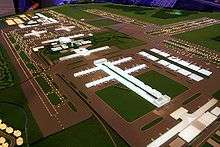
With the slight modification of the masterplan, the future Terminal 2's satellite terminal will be combined into one satellite terminal. The expansion of Terminal 2's satellite terminal will be exactly the same as Terminal 1's (the current Main Terminal) satellite terminal, where initially the satellite terminal will have four arms, and another four arms when the terminal reached its capacity. There is sufficient land and capacity to develop facilities to handle up to 97.5 million passengers a year, four runways by the year 2020 and two mega-terminals, each linked with satellite terminals.[6]
| Summary of Kuala Lumpur International Airport Masterplan | ||||
|---|---|---|---|---|
| Phase | Year | Description | ||
| Phase 1 | 1998 | Initial Capacity of 25 million Passenger Per Annum | ||
| 2006 | Capable of Handling 35 million Passengers per annum with the construction of Low Cost Carrier Terminal | |||
| Phase 2 | 2008 | Expansion of Low Cost Carrier Terminal to accommodate 40 Million Passengers per annum. | ||
| Phase 3 | 2011 | New Low Cost Carrier Terminal will be constructed to accommodate additional 30 million (55 million) passengers Per Annum, Current Low Cost Carrier Terminal converted to cargo usage. | ||
| Not fixed | Satellite Terminal B will be constructed to handle maximum of 75 million passengers. (One terminal accompanied by 2 satellite terminal and one low-cost carrier terminal) | |||
| Phase 4 | Not fixed | Terminal 2 and Satellite Terminal C will be constructed so that the airport is capable to handle 97.5 million passengers. | ||
A380 upgrades
The operator of Kuala Lumpur International Airport, Malaysia Airports Holding Berhad, had spent about RM135 million (approx) to upgrade facilities at the KL International Airport (KLIA) in Sepang to accommodate the Airbus A380. KLIA is the only airport in Malaysia that accommodate the landing and take off of the A380. Upgrading works started on 3 April 2006, and was completed by 28 May 2007. Works include the provision of shoulders on both sides of the two existing runways of 15 meters as well as the taxiways, building additional aerobridges at the three departure halls, namely C17, C27 and C37, and enhancing the mezzanine lounges for upper deck passengers of the aircraft at the departure halls. Emirates operates flights to Kuala Lumpur with the Airbus A380 commenced on 1 January 2012.[97] Malaysia Airlines also started its A380 services from Kuala Lumpur to London on 1 July 2012.[98]

References
- "Malaysia Airports: Airports Statistics 2018" (PDF). malaysiaairports. 2 April 2019. Retrieved 14 April 2019.
- WMKK – KL INTERNATIONAL/SEPANG at Department of Civil Aviation Malaysia
- "KLIA/KLIA2". Dive Into Malaysia. Retrieved 1 August 2019.
- "KISHO KUROKAWA".
- "History of KLIA". 1998. Archived from the original on 5 March 2008.
- "Phases of KLIA". 1998. Archived from the original on 26 August 2015.
- "First Flights of Kuala Lumpur International Airport". Department of Civil Aviation KLIA Branch. 1998. Archived from the original on 9 October 2007.
- "North Korean leader's brother Kim Jong-nam 'killed' in Malaysia'". BBC News. 14 February 2017. Retrieved 14 February 2017.
- "KLIA comes to a grinding halt". The Star. 23 August 2019. Retrieved 23 August 2019.
- "KLIA's opening marked with problems". Lim Kit Siang Media Release. July 1998.
- "Lufthansa to resume flights to KL next March". Travel Weekly Asia. 18 December 2003. Retrieved 13 February 2020.
- "Lufthansa to discontinue Kuala Lumpur service from March 2016". vimanphotography. 17 December 2015. Retrieved 13 February 2020.
- "Passengers at Kuala Lumpur Airport up despite fewer airlines". Asian Economic News. 6 August 2001. Archived from the original on 16 October 2015.
- "Airport Traffic Report" (PDF). 1998.
- For KLIA2, arrivals for can only use 32L while departures can only use 14R
- "ADS-B at Kuala Lumpur To Boost Landings, FIR Restructuring". Aviation International News. Retrieved 15 October 2017.
- "eAIP MALAYSIA". aip.dca.gov.my. Archived from the original on 15 October 2017. Retrieved 15 October 2017.
- Check-In News, Analysis and Event. "Kuala Lumpur's StB vision". Retrieved 31 August 2010.
- "Malaysia Airlines Recovery Plan Quarterly Update (1 Sept-30 Nov 15)." Malaysia Airlines. Retrieved on 5 May 2016.
- Chan Tien Hin. "AirAsia Has Record Drop on Loss, Analyst Downgrade." Bloomberg L.P.. 1 December 2008. Retrieved 27 September 2009.
- "Location Map Archived 1 January 2010 at the Wayback Machine." MASkargo. Retrieved 22 February 2010. "Malaysia Airlines Cargo Sdn. Bhd. 1M, Zone C, Advanced Cargo Centre KLIA Free Commercial Zone, Southern Support Zone Kuala Lumpur International Airport 64000 Sepang Selangor, Malaysia "
- "Contact Information Archived 9 August 2017 at the Wayback Machine." Malaysia Airports. Retrieved 23 May 2011. "Malaysia Airports Holdings Berhad Malaysia Airports Corporate Office, Persiaran Korporat KLIA, 64000 KLIA, Sepang, Selangor."
- "Contact." Malaysia Airlines. Retrieved 31 October 2012. "MAS Golden Boutiques Sdn. Bhd. 1st Floor, MAS Flight Management Building 64000 Sepang, Kuala Lumpur International Airport Selangor, Malaysia"
- "Kisho Kurokawa".
- "KLIA Introduces Integrated Self Check in Kiosks for Benefits of Passengers". Air Transport News. Archived from the original on 11 February 2012.
- "KLIA partners with SITA to be the first fully integrated Airport in Asia". Archived from the original on 29 October 2006. Retrieved 21 September 2005.
- "KLIA increase WiFi range". CAPA. Archived from the original on 27 January 2008. Retrieved 19 February 2008.
- "At KLIA: Old Malaya Kopitiam's signature Nyonya Laksa". www.tenthousandstrangers.com. Retrieved 15 February 2017.
- "9 firms shortlisted for KLIA retail expansion project". NST. Retrieved 16 February 2008.
- "Flight Check-In at KL Sentral". KLIA Ekspres. Retrieved 5 August 2014.
- "klia2 receives ICAO nod, first landing". Archived from the original on 25 April 2014. Retrieved 25 April 2014.
- "klia2 overview". Archived from the original on 2 May 2014. Retrieved 1 May 2014.
- "About klia2". Retrieved 24 April 2014.
- "klia2 opens to public". Retrieved 27 April 2014.
- "About gateway@klia2". Archived from the original on 7 April 2014. Retrieved 1 May 2014.
- "Public invited to tour and experience klia2 before May 2 opening". Retrieved 27 April 2014.
- "klia2 Coming Soon". Archived from the original on 26 April 2014. Retrieved 25 April 2014.
- https://www.airasia.com/my/en/press-releases/airasia-grows-its-route-network-into-china.page
- https://explorasa.my/2014/03/pengalaman-pertama-menaiki-airasia-dari-kl-ke-johor-bahru/
- "AirAsia Buka Rute Pontianak–Kuala Lumpur dan Medan–Johor Bahru". travel.kompas.com. 11 March 2015. Retrieved 31 January 2020.
- "AirAsia to move its operations in Yogyakarta to Yogyakarta International Airport, Kulon Progo starting 29 March 2020". AirAsia. Retrieved 19 March 2020.
- "AirAsia X to launch Kuala Lumpur-Ahmedabad service from 29-Apr-2020". CAPA. Retrieved 5 February 2020.
- "AirAsia X plans Okinawa launch in Jan 2020". routesonline. Retrieved 24 October 2019.
- Liu, Jim. "AirAsia X 3Q19 Sapporo service changes". Routesonline. Retrieved 6 June 2019.
- Airlineroute (6 January 2009). "Airlineroute on Twitter: "AirAsia X to operate 2 daily Kuala Lumpur â€" Singapore service from 10NOV19"". Twitter.com. Retrieved 31 October 2019.
- "AirAsia X schedules Singapore launch in Nov 2019". Routesonline. Retrieved 31 October 2019.
- https://amp.kompas.com/ekonomi/read/2017/08/27/093200926/garap-wisman-india-batik-air-buka-rute-ke-chennai-
- https://kompas.id/baca/utama/2017/08/26/batik-air-buka-rute-medan-kuala-lumpur-chennai/
- "Batik Air plans Chennai service from July 2017". routesonline. Retrieved 27 June 2017.
- http://m.harnas.co/2019/10/22/batik-air-buka-rute-cengkareng-kuala-lumpur
- https://amp.kompas.com/ekonomi/read/2017/08/27/093200926/garap-wisman-india-batik-air-buka-rute-ke-chennai-
- https://kompas.id/baca/utama/2017/08/26/batik-air-buka-rute-medan-kuala-lumpur-chennai/
- 西宁机场新开洛阳、张家界航线 恢复吉隆坡航线 (in Chinese). Yushu News. 31 October 2017. Retrieved 3 October 2019.
- https://www.thejakartapost.com/amp/travel/2020/02/08/citilink-launches-bandung-kuala-lumpur-route.html
- "19 Desember rute Internasional Kuala Lumpur-Banyuwangi resmi dibuka". Banyuwangikab.go.id. Retrieved 17 December 2018.
- https://www.citilink.co.id/rute-dps-kul
- https://batampos.co.id/2019/02/28/citilink-buka-rute-jakarta-kuala-lumpur/
- Liu, Jim. "Citilink files Pekanbaru – Kuala Lumpur schedule from late-Sep 2019". Routesonline. Retrieved 5 September 2019.
- https://travel.detik.com/travel-news/d-4407822/citilink-buka-rute-baru-surabaya-kuala-lumpur-pp
- Liu, Jim. "Ethiopian Airlines NS20 South East Asia routing changes". Routesonline. Retrieved 31 January 2020.
- "Indonesia AirAsia adds Banda Aceh – Kuala Lumpur route from Dec 2018". Routesonline. Retrieved 25 October 2018.
- "Indonesia AirAsia expands Malaysia network in 4Q19". Routesonline. Retrieved 31 October 2019.
- "AirAsia connects Kuala Lumpur to the hidden island paradise of Belitung". AirAsia. Retrieved 19 August 2019.
- https://www.channelnewsasia.com/news/singapore/covid19-jetstar-asia-resumes-flights-manila-bangkok-kuala-lumpur-12658394
- "Lanmei Airlines adds new SE Asia routes in late-March 2020". Routesonline. Retrieved 7 January 2020.
- "Lucky Air adds Lijiang – Kuala Lumpur route from Dec 2017". Routesonline. Retrieved 13 January 2018.
- Liu, Jim. "Malaysia Airlines revises Balikpapan service launch to mid-March 2020". Routesonline. Retrieved 3 March 2020.
- Liu, Jim (25 July 2019). "Malaysia Airlines schedules Beijing Daxing service from late-Dec 2019". Routesonline. Retrieved 25 July 2019.
- https://web.archive.org/web/20160906230331/http://www.malaysiaairlines.com/content/dam/malaysia-airlines/mas/PDF/bookandplan/timetable/MH%20August%202016.pdf
- "Malaysia Airlines Open The Kuala Lumpur-Kertajati". PT International Bandarudara West Java. Retrieved 14 February 2020.
- https://www.fb.com/kertajatiinternational
- Liu, Jim. "Malaysia Airlines resumes 2 Indonesian service in Feb 2020". Routesonline. Retrieved 7 January 2020.
- "We now fly to Pekanbaru and Solo". Malaysia Airlines. Retrieved 18 September 2019.
- "Long haul flights start at Istanbul's Sabiha Gökçen airport". ahvalnews.com. Retrieved 24 November 2019.
- "Malindo Air schedules Adelaide mid-April 2019 launch". routesonline. Retrieved 21 March 2019.
- "Malindo Air adds Da Nang from Nov 2019". Routesonline. Retrieved 18 October 2019.
- https://www.anna.aero/2016/05/17/malindo-air-jets-off-johor-bahru/
- https://www.routesonline.com/news/38/airlineroute/287810/malindo-air-resumes-sapporo-service-in-1q20/
- "Malindo Air schedules Sydney launch in mid-August 2019". routesonline. Retrieved 31 May 2019.
- Liu, Jim. "Malindo Air 1Q20 Domestic network addition". Routesonline.
- "Hello Zhengzhou". Malindoair.com. Retrieved 31 October 2019.
- Uploader. "PIA's flight operation for Kuala Lumpur from Oct 14 | Associated Press Of Pakistan". Retrieved 9 October 2019.
- Liu, Jim (26 November 2019). "Turkmenistan Airlines delays Malaysia resumption to Feb 2020". Routesonline. Retrieved 26 November 2019.
- https://www.vietjetair.com/Sites/Web/en-US/NewsDetail/news/2368/vietjet-launches-its-newest-international-route-connecting-ho-chi-minh-city-vietnam-with-kuala-lumpur-malaysia
- Flightradar24. "LX-VCL - Boeing 747-8R7(F) - Cargolux". Flightradar24. Retrieved 19 November 2017.
- "MASKargo Fleet & Network". MASKargo. Retrieved 1 November 2019.
- "MASKargo adds new intra-Asia routing in S18". Routesonline. Retrieved 27 June 2018.
- "MasKargo adds new China service in Nov 2016". routesonline. Retrieved 18 November 2016.
- "Menzies Macau welcomes MASkargo as a new Cargo customer". Menziesaviation.com. 26 January 2018. Retrieved 27 June 2018.
- "Network". maskargo.com.
- "MAB Kargo partners Azerbaijan carrier to expand cargo network".
- Flightradar24. "VQ-BWY - Boeing 747-83Q(F) - Silk Way West Airlines - Flightradar24".
- "Turkish Cargo launching 777F service to Kuala Lumpur". Air Cargo World. Retrieved 18 October 2019.
- Flightradar24. "N447UP - Boeing 757-24APF - UPS Airlines - Flightradar24".
- "Transport Statistics Malaysia 2018: Table 4.12 Traffic Movements Between Malaysian Airports (Including Singapore), 2018" (PDF). Ministry of Transport Malaysia. Retrieved 19 November 2019.
- "Kuala Lumpur International". Kiat.net. Archived from the original on 3 May 2012. Retrieved 19 April 2012.
- "MAHB upgrade KLIA to take in A380". NST. Retrieved 16 August 2006.
- "First Malaysia Airlines' A380 Revealed in Full Special Livery – Very encouraging demand for seats on Malaysia Airlines A380 flights". Malaysia Airlines. Retrieved 17 November 2012.
External links
| Wikimedia Commons has media related to Kuala Lumpur International Airport. |
